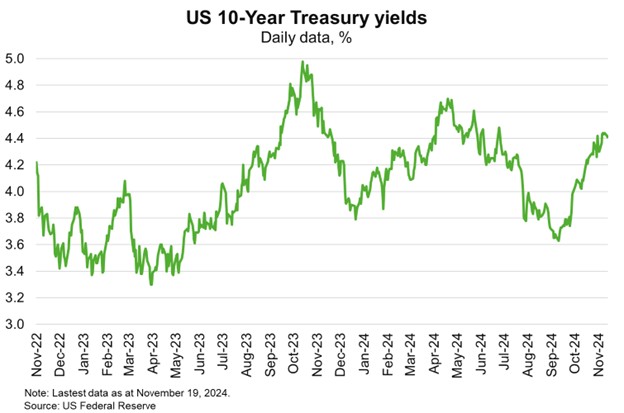© Export Finance Australia
The views expressed in World Risk Developments represent those of Export Finance Australia at the time of publication and are subject to change. They do not represent the views of the Australian Government. The information in this report is published for general information only and does not comprise advice or a recommendation of any kind. While Export Finance Australia endeavours to ensure this information is accurate and current at the time of publication, Export Finance Australia makes no representation or warranty as to its reliability, accuracy or completeness. To the maximum extent permitted by law, Export Finance Australia will not be liable to you or any other person for any loss or damage suffered or incurred by any person arising from any act, or failure to act, on the basis of any information or opinions contained in this report.
Australia—Prospects for inward looking US policies create export risks
Donald Trump became the 47th US President following elections in November, while the Republican Party gained control of Congress after securing majorities in the House of Representatives and Senate. Following the election, US stock prices rose, the US dollar strengthened and yields on 10-year Treasury bonds increased (Chart). Higher bond yields suggest investors see prospects of faster growth in the near term, but also the potential for higher inflation and public debt problems in the longer term.
Trump has promised higher import tariffs, corporate and personal income tax cuts, tighter immigration and fewer regulations. A 10%-20% across-the-board tariff and a 60% tariff on goods from China would increase the average US tariff rate from 2.5% to at least 17%, a level last seen in the 1930s. By reducing trade and distorting production, higher tariffs will likely weigh on the US economy. Meanwhile, tax cuts and fewer regulations could provide a near-term boost to US consumption and investment, but compound pressures on government finances. Indeed, Trump’s proposals are estimated to increase government debt to 134% of GDP in 2035, from 99% currently. Curtailing immigration would reduce labour supply in sectors that rely heavily on immigrants, potentially fuelling inflation. Trump may also dial back incentives for clean energy investments, which over time, could make the US more susceptible to climate shocks.
Australian exporters are likely to feel the effects through lower trade and a weaker exchange rate. An OECD study showed that Australia could suffer a 1.2% reduction in GDP as a result of a 10% reduction bilateral trade flows between major economies. Slower growth in China and weaker demand for resources would lower commodity prices. This would drag on the Australian dollar, particularly given prospects for higher US inflation and interest rates.

